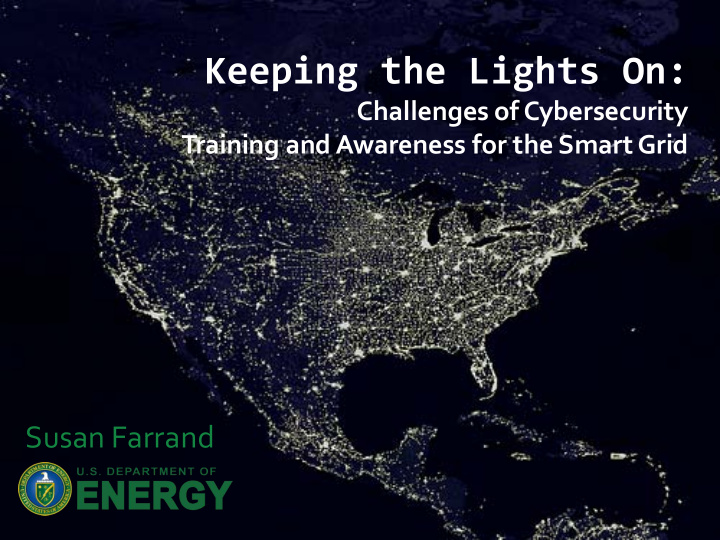



Keeping the Lights On: Challenges of Cybersecurity Training and Awareness for the Smart Grid Susan Farrand
What is the Grid? Why is the Grid like it is?
The War of the Currents Thomas Edison Nikola Tesla George Westinghouse
Electricity Evolution? Emerging technology in 1893 . . . Still influencing the grid today In the 1940s, connected local generation and transmission systems created an “electric grid.”
Today’s Electric Grid Three major linked regional power grids in the lower 48 states More than 3,000 utilities About 10,000 power plants Several hundred private and public transmission grid owners Approximately 130 balancing authorities Millions of power consumers More than 4,000 million megawatt-hours consumed annually .
What is the Smart Grid? How is it different?
The difference is like. . .
The Smarter Grid can. . . Heal itself Motivate consumer participation Resist attack Provide higher quality power Save money Accommodate generation and storage options Enable electricity markets to flourish Run more efficiently Increase use intermittent power generation sources
Source: “Upgrading the Grid”, Nature, vol 454, pp. 570-573, July 2008
The Smart Meter 225,000,000 Internet access points
Cybersecurity training, education, and outreach leverages human capital assets for protection of the Electric Grid.
Electric Grid Cybersecurity TEA Goals Increase Consumer Awareness of cyber-related security on the Electric Grid Promote Electric Sector Cybersecurity Training, Education, and Awareness Recruit and Retain a Workforce Skilled in Cybersecurity
Consumer Awareness Why? New technologies Changing security and privacy impacts Resistance to change What? Understanding their role Accepting their responsibilities How? Media targeted to each consumer segment Increased attention to cybersecurity in K-12 curriculum
Training, Education, and Awareness Why? Assure reliable power Support National security Protect the Grid Adapt to the increased use of information technology Meld cybersecurity practices into all aspects of business operations
Effective information security governance requires senior management commitment and an overall culture conducive to information security at the executive and operational levels. Too often, management determine that it is easier to buy a solution than to change a culture. . . Education and training in the operation of information security processes are often overlooked as well. However, management should consider that even the most secure system, if operated by ill-informed, untrained, careless or indifferent personnel, will not achieve a significant degree of security. ISACA Information Security Governance Guidance For Information Security Managers
Training, Education, and Awareness What? Adapt to a changing workforce Adapt to changing technology Cultivate a cyber-aware work environment Establish baselines for cybersecurity competency and proficiency Change the way cybersecurity is perceived
Training, Education, and Awareness How Communicate with all employees Assess existing skill levels Develop role-based cybersecurity training and education programs Incorporate cybersecurity concepts in occupational training programs Leverage training resources and best practices
Cybersecurity Workforce Implications of skilled workforce shortage The number and quality of qualified professionals is low. Recruitment is extremely competitive. Recruitment of new staff Retention and development of staff in practice National focus on qualifications for staff in significant cybersecurity functional roles Training and education opportunities
Cybersecurity Workforce Currently an estimated 2.28 million information security professionals worldwide Nearly 4.2 million by 2015 RESULTS: 1. Career opportunities for those with the right skills 2. Increased competition for skilled staff 2011 (ISC) 2 Global Information Security Workforce Study
Every occupation in the Electric Sector needs cybersecurity knowledge, skills , and abilities that match the evolving technology they use in their jobs. New thinking about the workforce and workplace and new human resources strategies are need for critical mission-based disciplines.
Electric Sector Workforce Impending volume of retirements Smaller hiring pool Undefined requirements for new skills Career stereotypes No standards, competency models, or career ladders Few mechanisms for knowledge transfer Cyber-related roles and responsibilities not well-defined Too few industry-defined, portable credentials Insufficient occupational training programs
Changes are coming. . . Human capital assets are critical to the protection of the Electric Grid. The public needs to understand how it will be impacted. The Electric Sector workforce must be ready and able to move forward. The industry must attract and retain skilled individuals for its workforce. Training and awareness must be comprehensive, timely, and continuous.
Contact Information: Sue Farrand US Department of Energy 202-586-2514 susan.farrand@hq.doe.gov
Recommend
More recommend